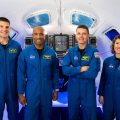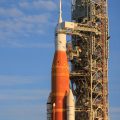
The 32-story-tall, two-stage Space Launch System (SLS) rocket and its Orion crew capsule were due for blast-off from the Kennedy Space Center in Cape Canaveral, Florida, during a two-hour launch window beginning at 8:33 a.m. EDT (1233 GMT).
But hopes of a liftoff within that window dimmed as engineers examined an apparent crack in some thermal protection material within the core stage, and were trouble-shooting an additional issue with one of the rocket’s four engines.
The program, named for the goddess who was Apollo’s twin sister in ancient Greek mythology, aims to return astronauts to the moon as early as 2025 after a five-decade hiatus.
It also seeks to establish a long-term lunar colony as a stepping stone to even more ambitious future voyages sending humans to Mars.
The maiden voyage of the SLS-Orion, a mission dubbed Artemis I, is intended to put the 5.75-million-pound vehicle through its paces and push design limits before the National Aeronautics and Space Administration deems it reliable to carry astronauts.
Billed as the most powerful, complex rocket in the world, the SLS represents the biggest new vertical launch system the U.S. space agency has built since the Saturn V flown during the Apollo moon program of the 1960s and 70s.
Just before midnight on Sunday, mission management teams gave the go-ahead to begin filling the rocket’s fuel tanks with several hundred thousand gallons of super-cooled liquid oxygen and liquid hydrogen propellant.
One issue cited by NASA officials last week as a potential show stopper for Monday’s launch would be any sign during rocket fueling that a newly repaired hydrogen line fitting had failed to hold. NASA officials said on Sunday they were also eyeing a potential, but minor, helium leak in launch pad equipment.
On Monday morning, roughly two hours before the launch window was due to open, engineers struggled to configure one of the rocket’s four engines for launch and examined a buildup of frost detected on an inner tank seal, according to NASA.
Engineers suspected the frost was from a potential crack in one of the joints connecting the rocket’s fuel tanks, NASA said, but that issue was resolved after determining the crack was on foam insulation and not the joint structure.
If the countdown clock is halted for any reason, NASA has set Sept. 2 and Sept. 5 as backup launch dates.
Otherwise, Monday’s countdown should end with the rocket’s four main R-25 engines and its twin solid-rocket boosters igniting to produce 8.8 million pounds of thrust, about 15% more thrust than produced by the Saturn V, sending the spacecraft streaking skyward.
About 90 minutes after launch, the rocket’s upper stage will thrust Orion out of Earth orbit on course for a 42-day flight that brings it to within 60 miles of the lunar surface before sailing 40,000 miles (64,374 km) beyond the moon and back to Earth. The capsule is expected to splash down in the Pacific on Oct. 10.
Although no humans will be aboard, Orion will be carrying a simulated crew of three – one male and two female mannequins – fitted with sensors to measure radiation levels and other stresses that real-life astronauts would experience.
Thousands of spectators gathered on shores around Cape Canaveral, staking out positions with binoculars in hand.
A top objective for the mission is testing the durability of Orion’s heat shield during re-entry as it hits Earth’s atmosphere at 24,500 miles (39,429 km) per hour, or 32 times the speed of sound, on its return from lunar orbit – much faster than more common re-entries of astronaut capsules returning from low-Earth orbit.
The heat shield is designed to withstand re-entry friction expected to raise temperatures outside the capsule to nearly 5,000 degrees Fahrenheit (2,760 Celsius).
More than a decade in development with years of delays and billions of dollars in budget overruns, the SLS-Orion spacecraft has so far cost NASA least $37 billion, including design, construction, testing and ground facilities.
NASA chief Bill Nelson has defended the program as a boon to space exploration and an “economic engine,” noting that in 2019 alone, for example, Artemis generated $14 billion in commerce and supported 70,000 U.S. jobs.
Among the program’s greatest financial beneficiaries are the principal SLS and Orion primary contractors – Boeing Co (BA.N) and Lockheed Martin Corp (LMT.N), respectively.
Twelve astronauts walked on the moon during six manned Apollo missions that landed from 1969 to 1972, the only spaceflights yet to place people on the lunar surface.
If successful, Artemis I will pave the way to a first crewed SLS-Orion mission, an out-and-back flight around the moon designated Artemis II, as early as 2024, to be followed a year or more later by an Artemis III journey to the lunar surface.
Artemis III involves a much higher degree or complexity integrating the SLS-Orion with a series of spacecraft to be built and flown by Elon Musk’s launch company SpaceX.
Those include SpaceX’s own heavy-duty Starship launch and lunar-landing vehicle, still under development, as well as several components that remain to be constructed – an orbital fuel depot and space tankers to fill it. Even the new moon-walking suits remain to be designed.
NASA’s Office of Inspector General last year said that the first Artemis III lunar landing was more likely to be achieved two to three years later than the agency’s late 2025 target date.








Sweet blog! I found it while searching on Yahoo News. Do you have any tips on how to get listed in Yahoo News? I’ve been trying for a while but I never seem to get there! Appreciate it